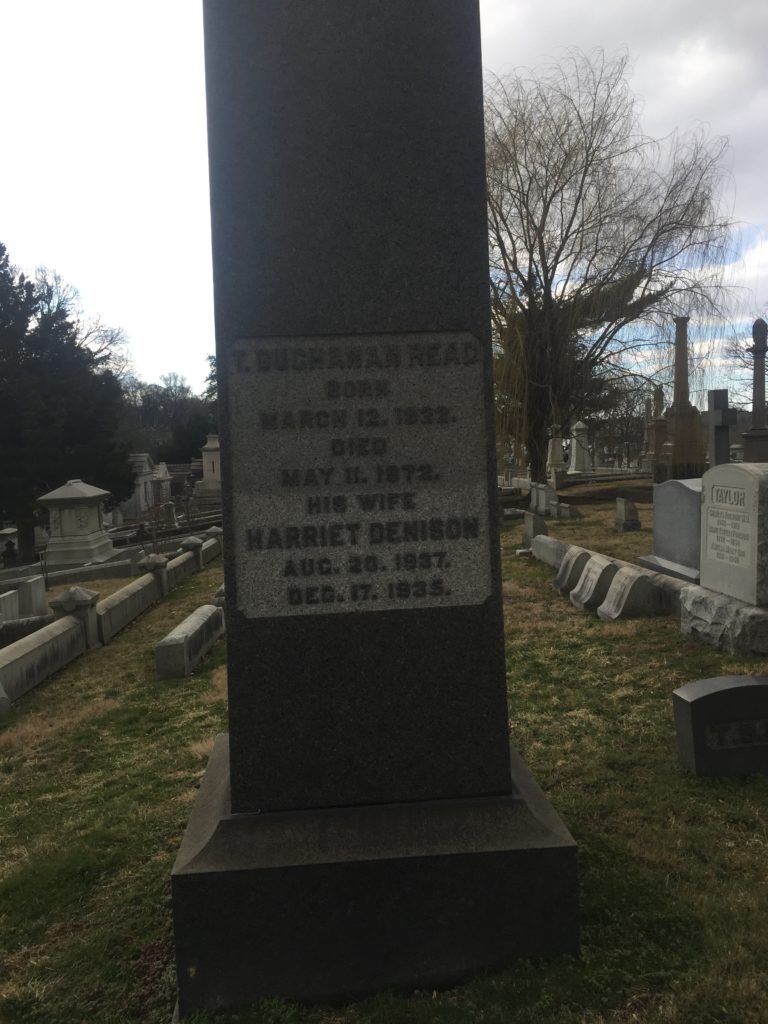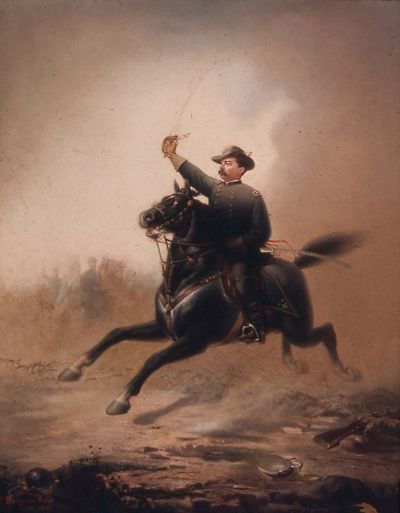Erik Visits an American Grave, Part 987
This is the grade of Thomas Buchanan Read.

Born in 1812 in Dowington, Pennsylvania, Read became an artist and poet. He was artistic from the time he was a kid but his family was very not supportive. In fact, it sounds like his parents were awful. At the age of 10, he escaped from home and lived with a sister in Cincinnati. He made his way as a worker, doing any number of basic jobs, including a grave engraver, endearing him to this series. But he also started in the theater, specializing in playing women’s roles, which was still common at this time. He also painted. What made him noticed by the public for the first time was a portrait he made of William Henry Harrison. He moved around a lot, went to Boston in 1841, and then to Philadelphia in 1846. In 1850, he went to Rome and then to London. He was financially successful, even if his work is mostly forgotten today.
When the Civil War began, Read was a huge patriot who did far more than a rich guy had to do. He immediately returned from London to serve in the military. He ended up on the staff of both Lew Wallace and William Rosecrans. Read’s poetry was often topical. One of his most famous was “Sheridan’s Ride,” an homage to Phil Sheridan after his dash to Cedar Creek to hold the Shenandoah Valley in 1864. Heck, let’s just read it:
Up from the South, at break of day,
Bringing to Winchester fresh dismay,
The affrighted air with a shudder bore,
Like a herald in haste to the chieftain’s door,
The terrible grumble, and rumble, and roar,
Telling the battle was on once more,
And Sheridan twenty miles away.And wider still those billows of war,
Thundered along the horizon’s bar;
And louder yet into Winchester rolled
The roar of that red sea uncontrolled,
Making the blood of the listener cold,
As he thought of the stake in that fiery fray,
With Sheridan twenty miles away.But there is a road from Winchester town,
A good, broad highway leading down:
And there, through the flush of the morning light,
A steed as black as the steeds of night
Was seen to pass, as with eagle flight;
As if he knew the terrible need,
He stretched away with his utmost speed.
Hills rose and fell, but his heart was gay,
With Sheridan fifteen miles away.Still sprang from those swift hoofs, thundering south,
The dust like smoke from the cannon’s mouth,
Or the trail of a comet, sweeping faster and faster,
Foreboding to traitors the doom of disaster.
The heart of the steed and the heart of the master
Were beating like prisoners assaulting their walls,
Impatient to be where the battle-field calls;
Every nerve of the charger was strained to full play,
With Sheridan only ten miles away.Under his spurning feet, the road
Like an arrowy Alpine river flowed,
And the landscape sped away behind
Like an ocean flying before the wind;
And the steed, like a barque fed with furnace ire,
Swept on, with his wild eye full of fire;
But, lo! he is nearing his heart’s desire;
He is snuffing the smoke of the roaring fray,
With Sheridan only five miles away.The first that the general saw were the groups
Of stragglers, and then the retreating troops;
What was to be done? what to do?–a glance told him both.
Then striking his spurs with a terrible oath,
He dashed down the line, ‘mid a storm of huzzas,
And the wave of retreat checked its course there, because
The sight of the master compelled it to pause.
With foam and with dust the black charger was gray;
By the flash of his eye, and his red nostril’s play,
He seemed to the whole great army to say:
“I have brought you Sheridan all the way
From Winchester down to save the day.”Hurrah! hurrah for Sheridan! Hurrah!
hurrah for horse and man!
And when their statues are placed on high
Under the dome of the Union sky,
The American soldier’s Temple of Fame,
There, with the glorious general’s name,
Be it said, in letters both bold and bright:
“Here is the steed that saved the day
By carrying Sheridan into the fight,
From Winchester–twenty miles away!”
I’m not exactly a reader of poetry, but hey, it’s pretty boring?
After the war, Read headed back to Italy. While in Rome, Read became associated with the Pre-Raphalite Brotherhood, the British movement that was dedicated to bringing back Italian classicism. Read continued as a portrait painter and painted Abraham Lincoln, Alfred Tennyson, and many others.
In 1872, Read was in England when he had a carriage accident. I’m not sure if he was intended to head back to Philadelphia before this or not, but he did. Unfortunately, the trip took place before he was recovered. While on board, he contracted pneumonia. He died shortly upon his return. He was 50 years old.
Let’s look at a bit of Read’s art too. The Smithsonian only owns one of his paintings (perhaps telling about how important or not this guy was). That is below:

Here’s a couple others:



Thomas Buchanan Read is buried in Laurel Hill Cemetery, Philadelphia, Pennsylvania.
“Sheridan’s Ride” is in the Library of America’s 19th Century Poetry collection. If you would like this series to visit the poets next to Read in this collection, you can donate to cover the required expenses here. Maria White Lowell is in Cambridge, Massachusetts and Phoebe Cary is in Brooklyn. Previous posts in this series are archived here.


